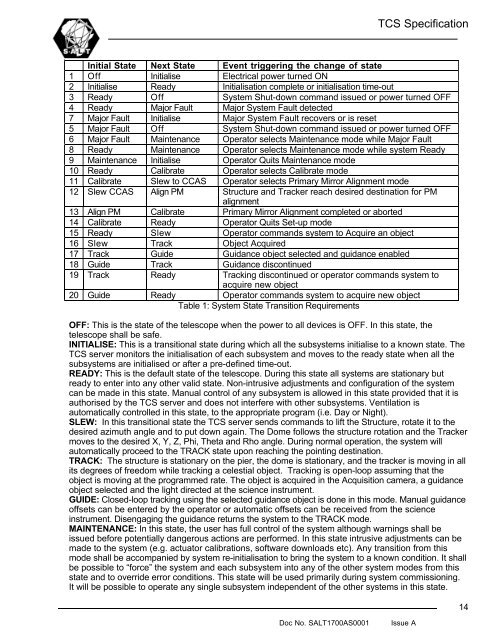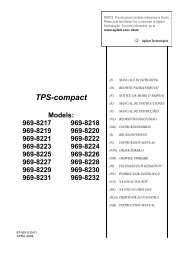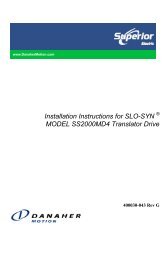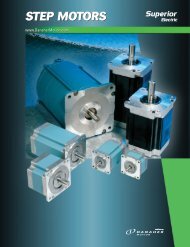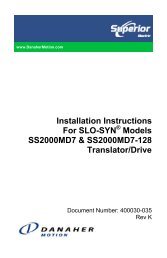1700AS0001 TCS Spec.pdf
1700AS0001 TCS Spec.pdf
1700AS0001 TCS Spec.pdf
You also want an ePaper? Increase the reach of your titles
YUMPU automatically turns print PDFs into web optimized ePapers that Google loves.
Doc No. SALT<strong>1700AS0001</strong> Issue A<br />
<strong>TCS</strong> <strong>Spec</strong>ification<br />
Initial State Next State Event triggering the change of state<br />
1 Off Initialise Electrical power turned ON<br />
2 Initialise Ready Initialisation complete or initialisation time-out<br />
3 Ready Off System Shut-down command issued or power turned OFF<br />
4 Ready Major Fault Major System Fault detected<br />
7 Major Fault Initialise Major System Fault recovers or is reset<br />
5 Major Fault Off System Shut-down command issued or power turned OFF<br />
6 Major Fault Maintenance Operator selects Maintenance mode while Major Fault<br />
8 Ready Maintenance Operator selects Maintenance mode while system Ready<br />
9 Maintenance Initialise Operator Quits Maintenance mode<br />
10 Ready Calibrate Operator selects Calibrate mode<br />
11 Calibrate Slew to CCAS Operator selects Primary Mirror Alignment mode<br />
12 Slew CCAS Align PM Structure and Tracker reach desired destination for PM<br />
alignment<br />
13 Align PM Calibrate Primary Mirror Alignment completed or aborted<br />
14 Calibrate Ready Operator Quits Set-up mode<br />
15 Ready Slew Operator commands system to Acquire an object<br />
16 Slew Track Object Acquired<br />
17 Track Guide Guidance object selected and guidance enabled<br />
18 Guide Track Guidance discontinued<br />
19 Track Ready Tracking discontinued or operator commands system to<br />
acquire new object<br />
20 Guide Ready Operator commands system to acquire new object<br />
Table 1: System State Transition Requirements<br />
OFF: This is the state of the telescope when the power to all devices is OFF. In this state, the<br />
telescope shall be safe.<br />
INITIALISE: This is a transitional state during which all the subsystems initialise to a known state. The<br />
<strong>TCS</strong> server monitors the initialisation of each subsystem and moves to the ready state when all the<br />
subsystems are initialised or after a pre-defined time-out.<br />
READY: This is the default state of the telescope. During this state all systems are stationary but<br />
ready to enter into any other valid state. Non-intrusive adjustments and configuration of the system<br />
can be made in this state. Manual control of any subsystem is allowed in this state provided that it is<br />
authorised by the <strong>TCS</strong> server and does not interfere with other subsystems. Ventilation is<br />
automatically controlled in this state, to the appropriate program (i.e. Day or Night).<br />
SLEW: In this transitional state the <strong>TCS</strong> server sends commands to lift the Structure, rotate it to the<br />
desired azimuth angle and to put down again. The Dome follows the structure rotation and the Tracker<br />
moves to the desired X, Y, Z, Phi, Theta and Rho angle. During normal operation, the system will<br />
automatically proceed to the TRACK state upon reaching the pointing destination.<br />
TRACK: The structure is stationary on the pier, the dome is stationary, and the tracker is moving in all<br />
its degrees of freedom while tracking a celestial object. Tracking is open-loop assuming that the<br />
object is moving at the programmed rate. The object is acquired in the Acquisition camera, a guidance<br />
object selected and the light directed at the science instrument.<br />
GUIDE: Closed-loop tracking using the selected guidance object is done in this mode. Manual guidance<br />
offsets can be entered by the operator or automatic offsets can be received from the science<br />
instrument. Disengaging the guidance returns the system to the TRACK mode.<br />
MAINTENANCE: In this state, the user has full control of the system although warnings shall be<br />
issued before potentially dangerous actions are performed. In this state intrusive adjustments can be<br />
made to the system (e.g. actuator calibrations, software downloads etc). Any transition from this<br />
mode shall be accompanied by system re-initialisation to bring the system to a known condition. It shall<br />
be possible to “force” the system and each subsystem into any of the other system modes from this<br />
state and to override error conditions. This state will be used primarily during system commissioning.<br />
It will be possible to operate any single subsystem independent of the other systems in this state.<br />
14


